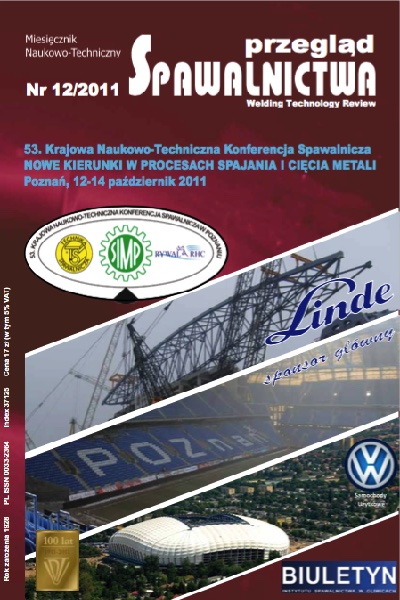Struktura i właściwości mechaniczne złączy doczołowych ze stopów magnezu spawanych metodą MIG
Main Article Content
Abstract
W artykule przedstawiono ocenę struktury i właściwości mechanicznych doczołowych złączy z odlewniczych stopów magnezu AZ91, AM-Lite i AM50 spawanych metodą MIG. Jako gaz osłonowy zastosowano mieszankę argonu i helu. Oceniano makro- i mikrostrukturę przy zastosowaniu mikroskopu świetlnego i elektronowego mikroskopu skaningowego na zgładach metalograficznych wykonanych w płaszczyźnie prostopadłej do kierunku spawania. Przeprowadzono analizę rozkładów pierwiastków stopowych przy zastosowaniu elektronowego mikroskopu skaningowego. Ocenę właściwości mechanicznych wykonano na podstawie rozkładów mikrotwardości w złączu oraz wytrzymałości na zginanie i rozciąganie złączy. Ocena wykazała, że możliwe jest uzyskanie wysokiej jakości złączy doczołowych ze stopów magnezu wykonanych metodą MIG. Odnotowano śladowe ilości porów w obszarze złącza.
Structure and mechanical properties of Mig welded butt-joints of magnesium alloys
Abstract
The paper presents the structure and mechanical properties of butt joint analysis of as-cast magnesium alloys AZ91, AM-Lite, AM50 welded with the use of MIG method. As the shielding gas the mixture of argon and helium is used. The macro- and microstructure on the cross-sections of perpendicular to welding direction using optic microscope and scanning electron microscope is analyzed. The surface analysis of main alloying elements with the use of scanning electron microscope is made. The mechanical properties of joints on the basis of microhardness distribution in the joints and bending and tension strength of joints. The results show the high quality butt joints of magnesium with the use of the MIG method is possible to achieved, however the presence of some pores are also observed.
Downloads
Article Details
Creative Commons CC BY 4.0 https://creativecommons.org/licenses/by/4.0/
Welding Technology Review (WTR) articles are published open access under a CC BY licence (Creative Commons Attribution 4.0 International licence). The CC BY licence is the most open licence available and considered the industry 'gold standard' for open access; it is also preferred by many funders. This licence allows readers to copy and redistribute the material in any medium or format, and to alter, transform, or build upon the material, including for commercial use, providing the original author is credited.
References
Kulekci M.K.: Magnesium and its alloys in applications in automotive industry, Journal of Advanced Manufacturing Technology, 39: 2008, 851-865.
Friedrich F. Schuman S.: Research for a new age of magnesium in the automotive industry, Journal of Materials Processing Technology, 117: 2001, 276-281.
Cao X., Jahazi M., Immarigeon J.P., Wallace W.: A review of laser welding techniques for magnesium alloys, Journal of Materials Processing Technology, 171: 2006, 188-204.
Abdel A al A.: Protective coating for magnesium alloy, Journal of Materials and Science, 43: 2008, 2947-2954.
Avedesian M.M., Baker H.: Magnesium and magnesium alloys, ASM Specialty Handbook, 1999.
Vesling F., Ryspaev T.: Effect of heat treatment on the superplasticity of magnesium alloys, Russian Journal of Non-Forrous Metals, 48: 2007, 57-62.
Lehner C., Reinhart G., Schaller L.: Welding of die-casted magnesium alloys for production, Journal of Laser Applications; 11/5: 1999, 206-210.
Kołodziejczak P., Kalita W., Kolasa A.: Spawanie stopów magnezu wiązką lasera CO2, Prace naukowe, Mechanika z. 215, s. 97-109.
Peng L., Yajiang L., Haoran G., Juan W.: Microstructure characteristics in TIG welded joint of Mg/Al dissimilar materials, Materials Letters, 61: 200, s. 1288-1291.
Tuz L., Kołodziejczak P., Kolasa A.: Struktura złączy stopów AZ91 i AM-Lite wykonanych metodą TIG, Przegląd Spawalnictwa, 12/2010, s. 41-43.
Abbott T., Dunlop G., Sweder T., Wojciechowski S., AM-Lite a New light weight cost effective alloy for decorative applications, Light Metals Age, 2006, www.am-technologies. com.au.
Atlas struktur znormalizowanych stopów odlewniczych, 1972, Instytut Odlewnictwa w Krakowie, WNT, 1972.
